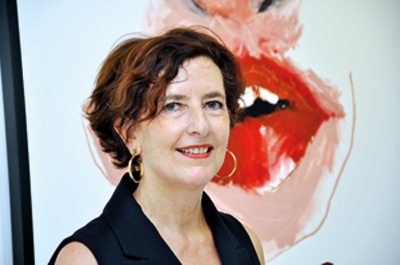An artist with a mission to seek the other

Fabienne Francotte: Strong strokes of exploration
‘Being the Other’ is an explorative collection by a Belgian artist that attempts to dive deeper into the human experience. Fabienne Francotte explains that “women are the roots of our society”, and their eyes are the windows to our pain and resilience. Her exhibition that opened at the Saskia Fernando Gallery in Colombo, on Thursday, is on until July 11.
This work is titled ‘Being the Other’ because she is focused on people especially those who do not have a voice in society for various “human reasons”, a collection she first created and exhibited in Bangladesh. Invited to work in refugees camps in Bangladesh (mostly with Rohingya refugees) in November last year, five months later, she shared her work in Dhaka because it was concentrated on those people at that time.
But then, Sri Lanka was attacked – the world was attacked.
Francotte has been living in Sri Lanka for three years and she exhibited her work at the Saskia Fernando Gallery last year, a series titled ‘It’s Like Someone Took My Soul” – black and white portraits representing people of different castes, minorities and religious groups. This time, her work is bigger and contains distinct and poignant colours. Her work is presented on canvases that stand about one metre tall and she uses large oil bars to convey her vision onto the canvas. Francotte primarily works with her hands, so she can put a little bit more of herself into her work. She prefers using oils because it is difficult to control, much like life itself.
 Francotte spent two years volunteering at the National Institute of Mental Health in Angoda where she held workshops and drew with the female and adolescent patients there. Being a teacher, not of art but of language (Dutch) for 20 years, she expected to find herself in a school but says wryly that she “ended up in Angoda”. Her mother suffered from Alzheimer’s for ten years, and that experience has taught her not to be afraid of mental illness.
Francotte spent two years volunteering at the National Institute of Mental Health in Angoda where she held workshops and drew with the female and adolescent patients there. Being a teacher, not of art but of language (Dutch) for 20 years, she expected to find herself in a school but says wryly that she “ended up in Angoda”. Her mother suffered from Alzheimer’s for ten years, and that experience has taught her not to be afraid of mental illness.
Here she could get close to Sri Lankans different to those she was meeting with her husband (the European Union ambassador to Sri Lanka) –her contact on the ground level while her husband was dealing with the government. So they had two views of Sri Lanka to share with people.
Trained in Arabic calligraphy, Francotte has been able to transfer this skill into her artwork, in the form of her strong and direct use of line work. She says that “when you leave stains on a piece of paper and you are not connected to that stroke it doesn’t say anything, there is no strength in it. It’s like having a religion when you are a non-religious person. Calligraphy is like you and you.” Francotte’s bridge from calligraphy to art was her students. The children she was teaching in Brussels would draw, but wouldn’t think about the three dimensions of what they were drawing. That inspired Francotte’s dive into fortuitous realism. Her work is unapologetic, to the point and explorative.
Francotte found her artform during a difficult time in her life, after a divorce; she felt that she was losing herself. So she started to draw herself. Then she started to draw bodies. She explains that in all of our bodies we have tattoos of everything we have been through, and even if we were to close that box, the painful chapters of our bodies will still be there. Her drawings today are not intended to be beautiful, but rather to express feelings. She wants to say something that we can’t see, but rather feel.
Being the Other invites the viewer to feel empathy. Without labelling people. Francotte’s observations on where the world is going, her frustrations about the actions that various governments and political bodies are taking, and their lack of communication drive her art. She wants us to get to the point; what is life about?

Saskia Fernando (above left) owner of the gallery and other guests at the exhibition opening. Pix by Priyantha Wickramaaarchchi


